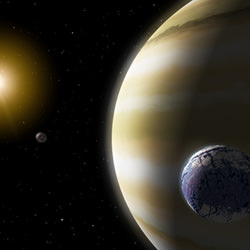
Artist interpretation of an extrasolar planet. Image credit: NASA. Click to enlarge.
An international collaboration featuring Ohio State University astronomers has detected a planet in a solar system that, at roughly 15,000 light years from Earth, is one of the most distant ever discovered.
Andrew Gould
In a time when technology is starting to make such finds almost commonplace, this new planet — which is roughly three times the size of Jupiter — is special for several reasons, said Andrew Gould, professor of astronomy at Ohio State .
The technique that astronomers used to find the planet worked so well that he thinks it could be used to find much smaller planets — Earth-sized planets, even very distant ones.
And because two amateur astronomers in New Zealand helped detect the planet using only their backyard telescopes, the find suggests that anyone can become a planet hunter.
Gould and his colleagues have submitted a paper announcing the planet to Astrophysical Journal Letters, and have posted the paper on a publicly available Internet preprint server, http://arXiv.org . The team has secured use of NASA’s Hubble Space Telescope in late May to examine the star that the planet is orbiting.
The astronomers used a technique called gravitational microlensing, which occurs when a massive object in space, like a star or even a black hole, crosses in front of a star shining in the background. The object’s strong gravitational pull bends the light rays from the more distant star and magnifies them like a lens. Here on Earth, we see the star get brighter as the lens crosses in front of it, and then fade as the lens gets farther away.
Because the scientists were able to monitor the light signal with near-perfect precision, Gould thinks the technique could easily have revealed an even smaller planet. “If an Earth-mass planet was in the same position, we would have been able to detect it,” he said.
On March 17, 2005, Andrzej Udalski, professor of astronomy at Warsaw University and leader of the Optical Gravitational Lensing Experiment, or OGLE, noticed that a star located thousands of light years from Earth was starting to move in front of another star that was even farther away, near the center of our galaxy. A month later, when the more distant star had brightened a hundred-fold, astronomers from OGLE and from Gould’s collaboration (the Microlensing Follow Up Network, or MicroFUN) detected a new pattern in the signal — a rapid distortion of the brightening — that could only mean one thing.
“There’s absolutely no doubt that the star in front has a planet, which caused the deviation we saw,” Gould said.
Because the scientists were able to monitor the light signal with near-perfect precision, Gould thinks the technique could easily have revealed an even smaller planet.
“If an Earth-mass planet was in the same position, we would have been able to detect it,” he said.
OGLE finds more than 600 microlensing events per year using a dedicated 1.3-meter telescope at Las Campanas Observatory in Chile (operated by Carnegie Institution of Washington). MicroFUN is a collaboration of astronomers from the US, Korea, New Zealand, and Israel that picks out those events that are most likely to reveal planets and monitors them from telescopes around the world.
“That allows us to watch these events 24/7,” Gould said. “When the sun rises at one location, we continue to monitor from the next.”
Two of these telescopes belong to two avid New Zealand amateur astronomers who were recruited by the MicroFUN team. Grant Christie of Auckland used a 14-inch telescope, and Jennie McCormick of Pakuranga used a 10-inch telescope. Both share co-authorship on the paper submitted to Astrophysical Journal Letters.
Two other collaborations — the Probing Lensing Anomalies NETwork (PLANET) and Microlensing Observations in Astrophysics (MOA) — also followed the event and contributed to the journal paper.
Ohio State scientists on the project included Darren DePoy and Richard Pogge, both professors of astronomy, and Subo Dong, a graduate student. Other partners hail from Warsaw University in Poland, Princeton University, Harvard-Smithsonian Center for Astrophysics, Universidad de Concepci?n in Chile, University of Manchester, California Institute of Technology, American Museum of Natural History, Chungbuk National University in Korea, Korea Astronomy and Space Science Institute, Massy University in New Zealand, Nagoya University in Japan, and the University of Auckland in New Zealand.
This is the second planet that astronomers have detected using microlensing. The first one, found a year ago, is estimated to be at a similar distance.
Gould’s initial estimate is that the new planet is approximately 15,000 light years away, but he will need more data to refine that distance, he said. A light year is the distance light travels in a year — approximately six trillion miles.
The OGLE collaboration is funded by the Polish Ministry of Scientific Research and Information Technology, the Foundation for Polish Science, the National Science Foundation, and NASA. Some MicroFUN team members received funding from the National Science Foundation, Harvard College Observatory, the Korea Science and Engineering Foundation, and the Korea Astronomy and Space Science Institute.
Original Source: OSU News Release
